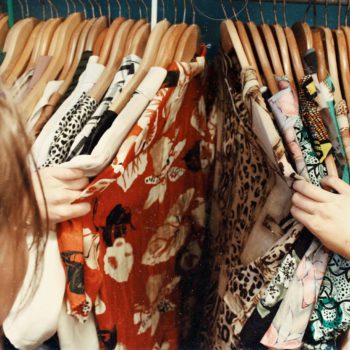|
|
We Reviewed. You Benefit.
Get Insider Access to Discounts on Top Sustainable Brands We've Reviewed Just for You! WEEKLY!
Fast fashion has been a transformative force in the fashion industry, revolutionizing how garments are produced, consumed, and discarded. While this model has brought affordable and trendy clothing to consumers worldwide, it has also profoundly affected garment workers and the environment. In this article, we will delve into the consequences of rapid fashion on apparel labourers, examining the working conditions, sustainability implications, and social impact of the fast fashion industry.
The Fast Fashion Business Model
Fast fashion means clothing brands introduce new styles and designs very quickly. This makes workers in the supply chain work fast and under bad conditions, often with low pay and few protections.
One prominent example of how bad it can be was when a factory called Rana Plaza collapsed in Bangladesh in 2013. This factory-made clothes for many big fashion brands and over 1,000 workers died when it fell. This made people start the Fashion Revolution movement, which wanted more honesty and responsibility in the supply chain.
Working Conditions and Exploitation

Textile workers, particularly in countries like Bangladesh, face numerous challenges in their working conditions. The pressure to meet production deadlines often leads to excessive overtime, leaving workers physically and mentally exhausted. Additionally, many brands in the fast fashion industry do not pay their workers a living wage, forcing them to live in poverty and struggle to meet their basic needs.
Furthermore, health and safety regulations are often neglected in garment factories, resulting in accidents and injuries. Workers are exposed to hazardous materials, such as dyes and chemicals, without proper protection, risking their long-term health. Additionally, the working environment in many factories is cramped and unsafe, compromising garment labourers’ well-being.
The Environmental Impact
The fast fashion model also takes a toll on the environment. The constant production and consumption of garments contribute to carbon emissions and water pollution due to the energy-intensive manufacturing processes and toxic chemicals in dyeing textiles. Moreover, the throwaway culture promoted by fast fashion leads to massive amounts of clothing ending up in landfills, exacerbating the already significant waste problem.
The rise of fast fashion companies and their disregard for sustainability has had devastating consequences for the environment. The fashion industry is one of the world’s largest polluters, and fast fashion’s rapid production and disposal cycle only exacerbates this issue.
The Call for Change: Sustainable Fashion

As the negative impacts of the fast fashion industry become more apparent, there has been a growing movement towards sustainable fashion. Sustainable fashion addresses the social and environmental concerns associated with fast fashion by promoting ethical production, fair wages, and environmentally friendly practices.
Many brands and consumers are now advocating for a shift towards a more sustainable fashion industry. This includes embracing practices like upcycling, recycling and purchasing second-hand garments to reduce waste and extend the lifecycle of clothing. Additionally, fashion companies are urged to reevaluate their supply chains, ensuring that workers are paid a fair living wage and that their working conditions are safe and respectful of their rights.
Furthermore, consumers have an essential role to play in creating change. By supporting ethical fashion brands and making conscious purchasing decisions, individuals can significantly impact the fashion industry. Embracing quality over quantity and reducing the demand for fast fashion can help create a more sustainable and equitable future for garment workers and the planet.
Frequently Asked Questions
The effects of rapid manner on apparel laborers can be severe and far-reaching. The overconsumption and disposable nature of fast fashion brands have led to exploitative working conditions, low wages, long hours, and health and safety risks for garment workers.
Fast fashion brands refer to clothing brands prioritizing quick production and turnover of affordable fashion items. Some of the most well-known fast fashion brands include Zara, H&M, Forever 21, and Primark.
The Rana Plaza incident was a tragic event in Bangladesh in 2013. An eight-story building housing several garment factories collapsed, resulting in the death of over 1,100 workers. This incident highlighted the unsafe working conditions and lack of regulations within the Bangladeshi garment industry.
Fashion Revolution is a global movement that advocates for a more transparent and ethical fashion industry. It aims to raise awareness about the social and environmental impacts of fashion production and consumption and encourages consumers to ask, “Who made my clothes?”
Rapid fashion’s focus on quick and cheap production often leads to compromised health and safety standards for garment workers. Many fast fashion brands outsource their manufacturing to countries with lax regulations, exposing workers to unsafe working conditions, such as overcrowded factories, inadequate safety measures, and poor ventilation.
Unfortunately, most fast fashion brands do not ensure that garment workers are paid a fair minimum wage. In countries like Bangladesh, where many fast fashion clothing items are produced, the minimum wage for workers in the garment industry is often well below a living wage, forcing workers to work long hours for meagre pay.
The fashion industry, particularly in the fast fashion sector, is known for its detrimental impact on the working conditions of garment workers. As the demand for quick and cheap fashion increases, workers are often subjected to long hours, little job security, and limited access to labor rights and protections.
The production of fast fashion involves the use of large quantities of water, energy, and resources. Additionally, disposing of fast fashion items contributes to significant textile waste and pollution. This throwaway culture perpetuated by fast fashion brands further strains the environment.
Consumers can support a more ethical fashion industry by opting for sustainable and ethical clothing brands, buying second-hand or vintage clothing, reducing their overall consumption, and advocating for better working conditions and environmental practices within the fashion industry.
Gender-based violence and harassment are prevalent issues many garment workers face, particularly women. Most fast fashion workers are women, often facing unequal treatment, low wages, and unsafe working conditions. The fashion industry needs to address and combat these gender-based inequalities.
Conclusion
The impact of fast fashion on garment workers cannot be ignored. The exploitative business model has resulted in low wages, poor working conditions, and a disregard for workers’ rights. Additionally, the environmental consequences of fast fashion, such as carbon emissions and waste pollution, further compound the adverse effects of this industry.
However, there is hope for change. The rise of sustainable fashion and the increasing awareness of the consequences of fast fashion have sparked a movement towards ethical production, fair trade, and environmentally friendly practices. By supporting sustainable fashion and making conscious choices as consumers, we can contribute to a more just and sustainable future for garment laborers and the fashion industry.












